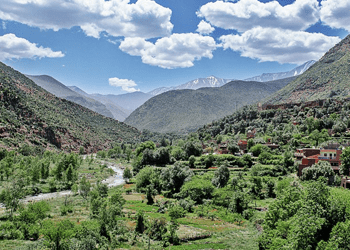
The Atlas Mountains dominate Morocco’s landscape, towering over 1000 meters and spanning nearly 1/4 of the country, accommodating 1/6 of its population. Stretching 1,600 miles (2,500 kilometers) through Morocco, Algeria, and Tunisia, they are North Africa’s highest mountains, flanking the Mediterranean Sea to the north. Comprising three main chains—the High Atlas, Middle Atlas, and Anti-Atlas—the High Atlas stands tallest, featuring Mount Toubkal near Marrakech, a must-see peak.
Geological history of The Atlas Mountains Morocco:
Hosting various cultures over centuries, the Atlas Mountains played a crucial role in North Africa’s development, providing water, minerals, and timber. They formed 300 million years ago during the late Paleozoic era, shaped by collisions between African and Eurasian tectonic plates. This geological activity also shaped mountain ranges globally, including the Appalachians in North America and the Urals in Russia.
Main chains of the Atlas Mountains:
High Atlas:
Encircling Marrakesh from the Atlantic near Agadir to Khenifra in the northeast, the High Atlas is the most visited region. Tourists come for hiking, climbing, and natural beauty, with peaks reaching 4,000 meters. Toubkal National Park, named after Mount Toubkal (4,167 meters), offers waterfalls, lakes, forests, and Berber villages.
Middle Atlas:
North of Fez, extending 300 km south to Marrakesh, the Middle Atlas ranks as Morocco’s second-highest range. It supports oak and cedar forests and diverse wildlife like the Barbary macaque. Jebel Bou Naceur (3,340 meters) dominates its landscape, with attractions including Cascades Ouzoud waterfalls and traditional Berber villages.
Anti-Atlas:
Stretching 500 km across southern Morocco, south of the High Atlas and east of the Atlantic, the Anti-Atlas features rugged terrain with cliffs and canyons. It includes cities like Ouarzazate and Tafilalt and boasts ancient volcanic formations and Jebel Siroua (3,304 meters).
Best time to visit based on weather conditions:
Yearly, visitors flock to the Atlas Mountains for activities like hiking and climbing. Spring (March-May) and fall (September-November) offer mild weather. Rain is common in spring and fall in the Middle Atlas. Summer (June-August) is hot and dry, while winter (December-February) is ideal for skiing and snowboarding, with colder temperatures at higher altitudes.
Explore the Atlas Mountains from Marrakech:
When in Marrakech, a visit to the Atlas Mountains is a must. It’s a short trip, offering Morocco’s natural beauty and renowned sites. Costs range from 300 to 600 dh ($30 to $60), with travel times varying from 1 to 2 hours.
Discovering the Atlas Mountains:
During your visit, explore local villages and their lifestyle. Enjoy traditional cuisine, interact with locals, and experience their customs. Popular spots include:
- Ourika Valley: Known for greenery, waterfalls, gardens, and Berber villages, ideal for swimming, hiking, and souvenirs.
- Imlil: Offering views of Jebel Toubkal, explore Berber architecture and visit Kasbah du Toubkal.
- Ouzoud Waterfalls: Cascading 110 meters, enjoy hiking, pools, boat rides, and picnics near Azila town.